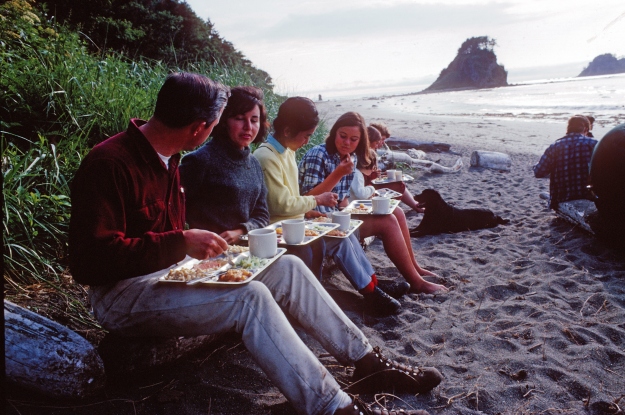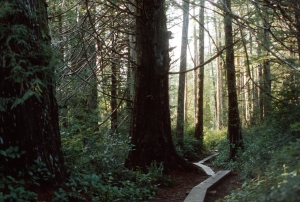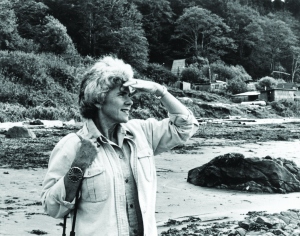 Ruth Kirk’s Ozette: Excavating a Makah Whaling Village presents a detailed account of a world-famous archaeological site on Washington’s Olympic Peninsula. Full-scale excavations from 1966 to 1981 revealed houses and their contents—including ordinarily perishable wood and basketry objects that had been buried in a mudflow well before the arrival of Europeans in the region. Led by Richard Daugherty, with a team of graduate and undergraduate students and Makah tribal members, the work culminated in the creation of the Makah Museum in Neah Bay, where more than 55,000 Ozette artifacts are curated and displayed. Ruth Kirk was present—documenting the archaeological work from its beginning—and her firsthand knowledge of the people and efforts involved enrich her compelling story of discovery and fieldwork, and deepen our understanding of a complex and storied culture.
Ruth Kirk’s Ozette: Excavating a Makah Whaling Village presents a detailed account of a world-famous archaeological site on Washington’s Olympic Peninsula. Full-scale excavations from 1966 to 1981 revealed houses and their contents—including ordinarily perishable wood and basketry objects that had been buried in a mudflow well before the arrival of Europeans in the region. Led by Richard Daugherty, with a team of graduate and undergraduate students and Makah tribal members, the work culminated in the creation of the Makah Museum in Neah Bay, where more than 55,000 Ozette artifacts are curated and displayed. Ruth Kirk was present—documenting the archaeological work from its beginning—and her firsthand knowledge of the people and efforts involved enrich her compelling story of discovery and fieldwork, and deepen our understanding of a complex and storied culture.
Here, we feature an excerpt from Ozette in which Ruth Kirk describes the location of the long-occupied coastal village and the earliest stages of the world-famous archaeological excavation of the site.
(Scroll to the bottom of this post to learn about upcoming opportunities to hear Ruth Kirk discuss Ozette).
The year was 1947. Richard Daugherty, a student at the University of Washington, was hiking the state’s wilderness Pacific coast, recording archaeological sites. World War II had ended, and with it his service as a navy blimp pilot flying patrols on the lookout for submarines. He had returned to his studies and in connection with them was making this survey of more than two hundred miles of coastline, from the mouth of the Columbia River to Cape Flattery. Not far from the cape, he had reached Ozette, the site of a Makah whaling village. A broad terrace bordered the beach for a half mile or more, and on it the walls of a few houses lay fallen into the grass and nettles, along with rotten roof boards covered with moss. Families had lived there until the 1920s, when they moved to Neah Bay, sixteen miles north.The federal government had ordered their children to be in school, yet had provided none at Ozette. They had no choice but to move.
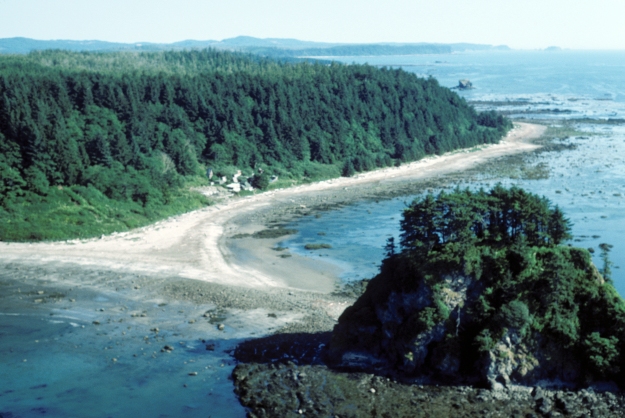
The main Ozette village stretched for about three-quarters of a mile along the beach, connected to Ch’kknow acht Island by a low-tide sandspit.
That exodus accounted for the end of the long human continuity at Ozette, but what were the beginnings? Midden—refuse—exposed in the sea bank edging the beach belonged to those earlier chapters. Lots of midden, and deep. Daugherty noted layer on layer of broken mussel and clam shells, whale bones, charcoal, and rocks cracked and split by the heat of a fire. This clearly was the premier site of the more than fifty he had recorded along the entire coast. He was seeing archaeological material that amounted to a cultural jigsaw puzzle belonging to the Makah people—and although he could not know it at the time, he was also looking at what eventually would provide the high point of his professional career.
Now the year was 1966. Daugherty had completed his PhD and joined the faculty at Washington State University, in Pullman. He had worked with other archaeologists in Egypt and Sudan, gathering evidence of the human past along the Nile River before it would be lost owing to construction of the Aswan Dam. He had consulted on Peace River archaeology in British Columbia and directed investigations in eastern Washington along the Snake and Columbia Rivers. But he kept wanting to get back to Ozette, and he found a way to do it. The National Science Foundation approved funds for research, and Daugherty recruited thirty archaeology students from across the United States and Canada to come and learn field techniques while helping unlock the story of Ozette’s past. The Makah Tribal Council had approved the undertaking.
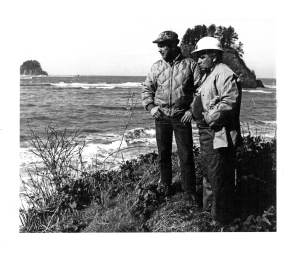
Richard Daugherty (left) and Ed Claplanhoo assessed the sea-bank erosion caused by winter’s storm-driven waves.
Ed Claplanhoo, a young councilman at the time, was a graduate of Washington State College (now University), and he knew Professor Daugherty. Consequently the council asked his opinion of Daugherty’s proposal. Years earlier they had declined a University of Washington request for permission to excavate at Ozette, but they could see merit in the current proposal as a way of strengthening the tribe’s tie to Ozette and they trusted Claplanhoo’s assessment. The federal government was considering “surplusing” the land at Ozette as vacant and no longer eligible for status as an Indian reservation. However, several Neah Bay elders had lived there as children, and they cared deeply about those roots.
Hamilton Greene, one of the elders, remembered “a solid line of houses facing the water, and canoes on the beach. My grandfather used to say that Ozette had been a big village. The word he used to describe it means ‘a whole bunch.’ More [houses] than you’d care to count.” Daugherty’s proposal seemed like a way to augment such memories with a new kind of knowledge. The tribe and the professor would work together.
The archaeology camp was set up just back from the beach, where a splashing creek furnished water for drinking and for icy showers. On days when it was not raining, the crew ate out on the beach, sitting on drift logs. On drizzly days, they gathered in a large, floorless tent designated as mess hall and classroom. A Coast Guard helicopter had brought in the big tent and smaller sleeping tents, a cookstove, groceries, shovels, surveyor’s transits, and field notebooks and laboratory catalogs with blank pages to be filled with information day-by-day as the excavation progressed. It was a onetime delivery. From then on, supplies had to be backpacked four miles through the forest and along the beach or flown in by a small plane twenty-four miles from the logging town of Forks. Often it was too foggy for the plane to land, and, for the same reason, travel often was unsafe by boat from Neah Bay, sixteen miles north, or La Push, eighteen miles south.
By modern standards Ozette is isolated and remote, but it was quite the contrary during its long years as a village approached from the sea. Sixteen houses stood there in 1834, according to the report of three shipwrecked Japanese seamen who had drifted for more than a year across the Pacific Ocean before finally being washed ashore and captured by Ozette Indians. They were subsequently rescued by the Hudson’s Bay Company and eventually taken to Macao, a trade center on the southeast coast of China. A half century later, the 1889 Pacific Coast Pilot also mentioned Ozette, with a reporter stating: “Passed close outside [Ozette] and had a fine view of it. The village has over 20 houses and is not bulkheaded to prevent the inroads of the sea.”
There could scarcely have been a better setting for Northwest Coast human life. Several offshore islands and a wide rocky reef at the village doorstep broke the force of swells and incoming waves, thereby easing the landing of canoes. The reef, exposed at low tide, hosted year-round edibles such as mussels, clams, sea urchins, snails, chitons, limpets, crabs, and octopus. About twelve miles west, nutrient-rich water welled up from the edge of the continental shelf and concentrated the plankton; fish fed on the plankton, and fur seals fed on the fish. That abundance of food brought migrating seals closer to shore at Ozette than anywhere else along the entire coast from Northern California to Alaska. Sea lions hauled out on the rocky points and beaches of the islands. Kelp beds furnished ideal habitat for sea otters. Red snapper and lingcod—bottom fish—thrived close to the village. Halibut banks were a short paddle away, and salmon came to the Ozette River a little over a mile to the north. Red cedars in the forest behind the village supplied planks for houses and bark for baskets, and they also could be made into dugout canoes. Deer and elk roamed the forest, which was interspersed by treeless prairies where villagers could gather a variety of plant foods and medicines.
—
Ruth Kirk, writer and photographer, is the author or coauthor of numerous books, including Archaeology in Washington, with her husband Richard D. Daugherty; Sunrise to Paradise: The Story of Mount Rainier National Park; and Exploring Washington’s Past: A Road Guide to History, with Carmela Alexander. Her writing has earned her many accolades, including the John Burroughs Medal for Natural History Writing and a National Book Award nomination. Kirk also has received recognition for her writing from both the New York Academy of Sciences and the American Library Association.
Meet Ruth Kirk and pick up a signed copy of Ozette at these upcoming events:
- Washington State Historical Society at the Washington State Capitol, Olympia with UW Press Senior Acquisitions Editor Regan Huff, April 6 at noon
- Seattle Public Library with Hannah Palin (UW Special Collections), book talk and screening of newly digitized footage of the Ozette dig, April 19 at 2:00 p.m.
- Mountaineers Seattle Program Center with Ozette Archaeologists, May 29 at 7:00 p.m.

